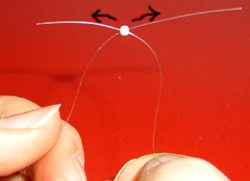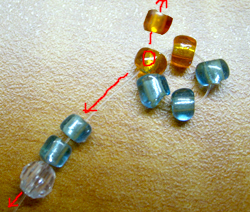|
Beader Comments: |
| Cindybell on August 3, 2016: |
| I am in. |
| Deliverance on July 27, 2015: |
| Superbly ilmuiinatlng data here, thanks! |
| Dianna on June 30, 2015: |
| Which is the inside and outside thread? Thanks! |
| Bonnie Clemons on January 1, 2015: |
| Love to try this |
| Trudi on February 3, 2014: |
| How an you make a ruffle where the beading goes on a right-hand slant? |
| Susan on May 24, 2013: |
| Hi! Can you please tell me how to do ending for beaded purse with clasp? Is it tie knot at the purse clasp or at beaded part? Thanks. |
| Sh on January 31, 2013: |
Your website doesn't work properly on my Apple computer. In the text areas, there is one word per line. Actually, everything banks to the left side of the screen.
fyi...thanks |
| Patricia Green on December 28, 2012: |
| Thank you for sharing |
| Lynn on October 10, 2012: |
| @ducky... Happy to help... Pattern sent... Have removed yr e-mail so you don't get 'spammed'. Always happy to receive 'freeware' patterns... Please do not share patterns you have purchased as that is how we designers 'earn a buck'... Thanks... Lynn |
| ducky on October 10, 2012: |
Lynn, thank you so much for your help. I am truly greatful for this. My email address is (removed by moderator)
If there are any patterns that you would like me to share with you I will try and do so. thank you again for the help! |
| Lynn on October 4, 2012: |
@ ducky...Have a pattern for 'Twinkle' mouse (very similar).. if any good, leave me yr e-mail..
|
| ducky on October 4, 2012: |
| I have been looking for a particular beading pattern for over 3 years now. If anyone can help me please I would be very grateful. On the webite " I Love Beading " there is a 3D crystal mouse named " Hammi the Loving Mouse " this beading site is down. The new site is " Beading.My " I have contacted them but no answer yet. I also contacted " The Lone Beader " who named the mouse. iCy from the first site mentioned in her post that she got the pattern from a Japanese book. I have searched the web forever it seems and still can not find this pattern. I will pay for the pattern if anyone happends to have it. Thank you |
| PINK 4 ME on September 5, 2012: |
| keren |
| Rosemarie Lasky on July 12, 2012: |
| Hi I just happened upon your web site.What a pleasure hope I can learn a lot. Please keep up the beautiful work. |
| Annie on April 30, 2012: |
| When I try to croos the bead with the fishing line and I pull the fishing line together , the bead pops out at the end of the crossing it doesnt tie together like in the picture.... |
| Lynn on October 31, 2011: |
| AuntDD67 - go to the home page and scroll down to the bottom... there is advice there for printing off the site. |
| AuntDD67 on October 30, 2011: |
| I'm having a problem when I print instructions, sometimes the text and illustrations overlay or the sidebar ads overlay the instructions. How do I prevent this in the future? |
| Birdie on May 23, 2011: |
| Kudos to you! I hadn't thugoht of that! |
| nagwa on May 15, 2011: |
| woooooooooooow |
| Erin Small on March 14, 2011: |
| How do you? |
| Kat on February 22, 2011: |
| Would appreciate Paso Doble Bracelet Pattern instructions. We understand there are some very nice designs that can be done using a variety of beads. |
| BlueOpalSpirit on January 28, 2011: |
| I am looking for a pattern to make large beads by bead weaving them... any ideas? thanks in advance! |
| rossa on January 7, 2011: |
| good job |
| anat dor on October 16, 2010: |
| I'm an amateur beads |
| Julia on June 26, 2010: |
| beadspage.com has 2 free video lessons on its main page. You can learn and buy ebooks on how to bead. A singapore registered company. Material are cheap too. |
| izza aulia on February 21, 2010: |
| aku pengen nyoba nich....... |
| AJ on September 4, 2009: |
| I've never done this kind of beading before - but I'm excited to try it and appreciate all the awesome patterns you have here! |
| Xtina on July 13, 2009: |
| So when i start a pattern i start in the middle of the string? Especially the Chinese Lantern. |
| millie on April 28, 2009: |
| I love this site fabulous patterns I love the great instructions |
| Debbie on December 13, 2008: |
| Hi love your site and fab instructions. Have a wonderful Christmas & fantastic beading 2009 |
| Priscilla on September 18, 2008: |
| Thanks for providing all of these great ideas. I haven't started beading yet, but you've kept things simple. I can't wait to give it a try. |
| Allegra on July 21, 2008: |
| The teddy bear pattern is next on my to-do list because everyone has requested it! It's quite in demand! |
| Laura on July 20, 2008: |
| Do you have the teddy bear pattern? I would like to try to make one. |
| Allegra on June 26, 2008: |
| Hey Laura, I promise you the beaded teddy bear pattern will be up and ready for you to make as a Christmas tree decoration!! I'm very thankful for your patience and support and wonderful words! |
| Laura on June 25, 2008: |
Great site! I love the teddy bear, he'd make a great addition to Christmas presents as a tree ornament.
|
| Lindsey on May 29, 2008: |
| I love this website it is like heaven to a beader who loves to find awsome new patterns. Please add new directions soon. |
| Christine on January 9, 2008: |
| This is a great website! I've made all the models posted! Can't wait to see more! |
| Eric on December 31, 2007: |
| Does anyone know how to tie a knot? That doesn't seem to be explained here. Thanks! |









